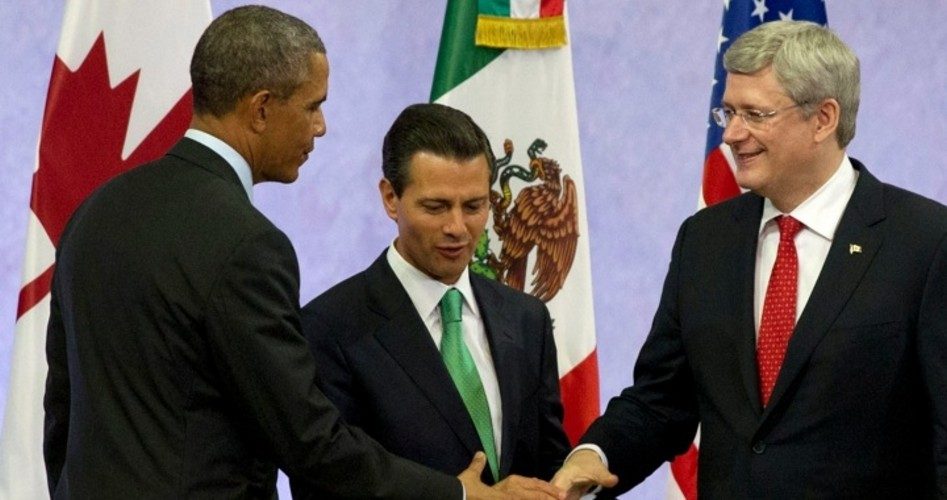
President Obama’s February 19 meeting in Toluca, Mexico, with Canadian Prime Minister Stephen Harper (right) and Mexican President Enrique Peña Nieto (center) did not produce any big, headline-grabbing breakthroughs, but that does not mean that it didn’t lay new ground for political and economic integration of the three nations. In fact, in their Joint Statement issued at the conclusion of the summit, the three leaders affirmed their commitment to a number of initiatives, many of which are already far developed, including approval of the Trans-Pacific Partnership (TPP), the “trade” agreement that is stirring widespread opposition in all three countries.
The controversial TPP is evoking broad-spectrum hostility particularly because of the total secrecy under which it has been crafted; while the American public and even the U.S. Congress have been kept from seeing the text, privileged corporations and NGOs have been given full access to the negotiated documents. The portions of the agreement that have been publicly leaked have confirmed that it poses a serious threat to national sovereignty, both from international institutions (such as the United Nations and the WTO) as well as multi-national corporations. The Joint Statement unequivocally endorses the TPP, declaring:
We seek to set new standards for global trade through the prompt conclusion of a high standard, ambitious, and comprehensive Trans-Pacific Partnership.
This is similar to the language of the Joint Statement issued by Obama, Harper, and then-President of Mexico Felipe Calderon at the 2012 Summit of North American Leaders, which declared:
The Trans-Pacific Partnership (TPP) provides an opportunity to further deepen our trade relationship and create jobs. The United States welcomes Canada’s and Mexico’s interest in joining the TPP as ambitious partners.
The TPP is an attempt to forge a supranational government for the nations of the Pacific Rim modeled after the European Union. There are currently 12 members of the TPP: United States, Mexico, Canada Australia, Brunei Darussalam, Chile, New Zealand, Peru, Singapore, Vietnam, Malaysia, and Japan.
The TPP represents the latest attempt of the globalists in the Washington ruling elite to greatly expand the power and reach of 20-year-old NAFTA, the North American Free Trade Agreement. Following the example of the European Union, they are pursuing a twin path of “broadening and deepening.” Broadening refers to the process of adding new member nations; deepening refers to the process of greater and greater “integration” and “harmonization,” the progressive convergence and intertwining of economic, political, and social sectors of the individual countries into a regional government, over which the citizens and their elected officials would have less and less control and accountability. Eventually, the various supranational regional governments would be merged into a world government under the United Nations, World Trade Organization, International Monetary Fund, and other UN-related agencies.
Following the establishment of NAFTA in 1994, under the Clinton administration, President George W. Bush attempted to deepen the U.S.-Canada-Mexico tri-national region with the Security and Prosperity Partnership (SPP), but public opposition spearheaded by this publication, The John Birch Society, WorldNetDaily, Phyllis Schlafly’s Eagle Forum, and other pro-independence, pro-Constitution groups, forced the Bush administration to shelve the plan — temporarily — and drop the tainted SPP moniker. At the same time, the Bush administration was pushing the broadening agenda, under the banner of the Free Trade Area of the America’s (FTAA), an endeavor launched during the Clinton administration to expand NAFTA to include all the nations of North and South America. As with the SPP, an awakened electorate put sufficient heat on the U.S. Congress to torpedo the FTAA. The subversive integration/merger plans that The New American had been exposing for years were confirmed in 2011 with the release by WikiLeaks of U.S. State Department cables showing that U.S. officials had been colluding with their Canadian and Mexican counterparts to undermine our constitutional government through various “integration” schemes. (See here and here.)
CFR Handprints on Every Page — No Surprise There
As with NAFTA and all of the other myriad “free trade” agreements that have flooded out of the current Obama administration and the Bush I, Clinton, and Bush II administrations, the actual fountainhead for the texts continues to be the Council on Foreign Relations (CFR) and its allied think tanks and media spigots. Carla A. Hills, a top CFR insider, is but one of the brain trust’s key operatives promoting the TPP. In testimony on January 15, Hills laid out the CFR line on the TPP as a broadening-deepening upgrade to NAFTA. Her statement before the House Committee on Foreign Affairs Subcommittee on the Western Hemisphere, entitled, “NAFTA at Twenty, Accomplishments, Challenges, and the Way Forward,” called for more U.S. integration with Canada and Mexico, while moving forward with the TPP (of which Mexico and Canada are already partners) and also bringing Canada and Mexico into the Transatlantic Trade and Investment Partnership (TTIP) currently underway to merge the United States and EU into a super-regional bloc. Hills, a co-chair of the CFR board of directors, told the subcommittee:
In 2012 Mexico and Canada joined the United States and eight other nations to negotiate a Trans-Pacific Partnership (“TPP”) to link the Asia and Pacific regions. Having our two neighbors at the table will better enable us to take positions to maintain and advance the unique competitiveness of the North American Region. It also gives us an attractive opportunity to address issues that were not relevant when the NAFTA was negotiated.…
It also provides an opportunity to harmonize a number of conflicting trade rules.… Today there are eight existing bilateral trade agreements between the three NAFTA governments and other TPP participants that were negotiated after the NAFTA came into being…. These differences could be dealt with in the TPP agreement.
Then, on to the push for the TTIP. According to Hills:
Third and most importantly, a North American-European Union Trade Agreement. Last year the United States and the European Union’s 28 states launched a comprehensive Trans-Atlantic Trade and Investment Partnership (“T-TIP”). The third round of negotiations occurred this past December.
Without question the T-TIP is a very big deal…. Failure to include Canada and Mexico in T-TIP would erode the unique and hugely beneficial economic integration that we have achieved with our two neighbors as a result of the NAFTA.
Carla Hills is one of the big movers and shakers in globalist circles. Besides being a longtime CFR officer and current co-chair of the organization (along with Robert Rubin, former U.S. treasury secretary and former co-chair of Goldman Sachs), she is also chair and CEO of Hills & Company (her international consulting firm), a member of the executive committees of the Trilateral Commission and the International Crisis Group, and an attendee of the secretive Bilderberg Group meetings. The biography for Hills on the official U.S. Department of State website dated March 12, 2012 says:
Over the past 25 years Mrs. Hills has served on a number of corporate boards of directors. She currently serves on the International Boards of J.P. Morgan Chase, Rolls Royce, and the Coca-Cola Company and is a member of the Board of Gilead Sciences. Mrs. Hills is also actively involved with a number of eleemosynary organizations, serving as Co-Chair of the Council on Foreign Relations, of the Inter American Dialogue, and of the International Advisory Board of the Center for Strategic and International Studies; Chair of the National Committee on U.S.-China Relations, … among others.
Hills was also a member of the CFR’s high-powered Independent Task Force that produced the 2005 report entitled Building a North American Community, a full-throated call for continental merger. Robert Pastor (CFR member), frequently cited as “the father of the North American Union,” was the principal co-chair of that task force; he is the author of the 2001 book, Toward a North American Community, and the 2011 book, The North American Idea: A Vision of a Continental Future, both of which promote the CFR program of hemispheric integration. Pastor, who passed away recently, gained infamy for subversive activities during the Carter administration, working under national security advisor Zbigniew Brzezinski, and also working closely with the radical-Marxist Institute for Policy Studies (IPS).
Pastor and Carla Hills were also among the current and former U.S. officials that attended a secret conference in Banff, Alberta, in 2006 to discuss continental merger plans with foreign counterparts. The U.S. participants included Defense Secretary Donald Rumsfeld, former Secretary of State George Shultz (CFR), former Central Intelligence Agency Director R. James Woolsey (CFR), former Immigration and Naturalization Services Director Doris Meissner (CFR), former Defense Secretary William Perry (CFR), and others. Exposure of that secret meeting and the SPP stealth agenda to surreptitiously carry forward the transnational merger in violation of the U.S. Constitution, and without the knowledge and consent of the American people, caused another firestorm that helped stop the SPP version of the NAU.
However, that did not mean “game over”; the globalists merely shifted gears, changed their game-plan labels, and rotated in some new players. As we reported concerning the Obama TTIP-TPP program:
Heading up Team Obama’s official TTIP effort is U.S. Trade Representative Michael Froman (CFR), who is described in his official USTR bio as “President Obama’s principal advisor, negotiator and spokesperson on international trade and investment issues.” Froman’s chief deputy at USTR is Miriam Sapiro (CFR). Leading the effort with Froman is undersecretary of state for economic growth, energy, and the environment (and longtime Washington insider) Robert D. Hormats (CFR). Froman and Hormats have been busy for months lining up top-level support for TTIP in speeches before business, banking, and industry groups. They are both Wall Street insiders. Froman was a managing director at Citigroup, and also served as president and chief executive officer of CitiInsurance before joining the Obama administration. Hormats was vice chairman of Goldman Sachs International. Both men were principals in massive corruption scandals (Froman in the bailout of Citigroup, Hormats in PetroChina’s takeover of Sudan’s oil).
The late Admiral Chester Ward was a longtime CFR member who became one of its most notable critics. According to Adm. Ward, the goal of the CFR’s leaders is the “submergence of U.S. sovereignty and national independence into an all-powerful one-world government.” James Perloff’s definitive book on the CFR, The Shadows of Power: The Council on Foreign Relations and the American Decline, together with numerous articles in this magazine over the years, has shown Admiral Ward’s evaluation of the organization to be spot-on.
Related articles:
Trans-Pacific Partnership (TPP): Assault on Our Sovereignty, Our Constitution, Our Liberty (Video)
The North American Union – The New American Magazine – Special Issue
Trans-Pacific Partnership (TPP): Bigger and More Dangerous Than ObamaCare (Video)
Secretly Trading Away Our Independence
North American Union: From NAFTA to the NAU
Goal of TPP: Free Trade Area of the Asia Pacific (FTAAP)
WikiLeaks Exposes North American Integration Plot
WikiLeaks Confirms North American Integration Scheme
North American Integration Continues After Robert Pastor
EU/U.S. — Transatlantic Convergence
CFR Applauds European Union’s “Real Subversion of Sovereignty”




